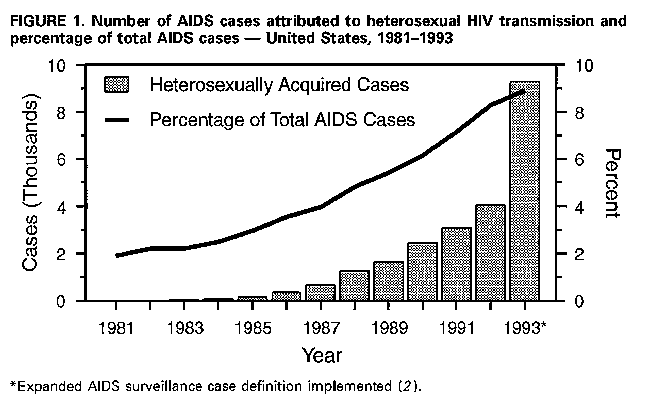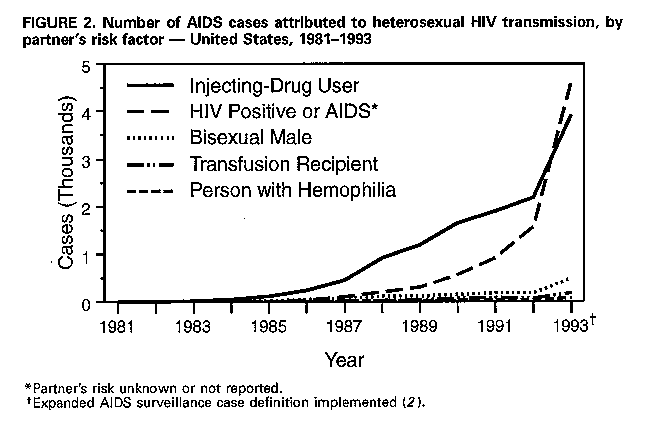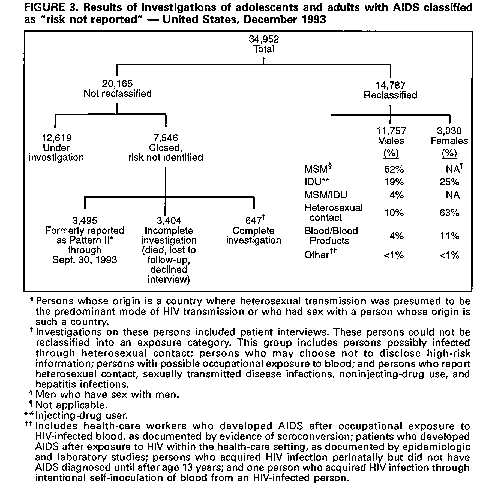 |
|
|
|
|
|
|
| ||||||||||
|
|
|
|
|
|
|
||||
| ||||||||||
|
|
|
|
|
Persons using assistive technology might not be able to fully access information in this file. For assistance, please send e-mail to: mmwrq@cdc.gov. Type 508 Accommodation and the title of the report in the subject line of e-mail. Current Trends Heterosexually Acquired AIDS -- United States, 1993From 1991 through 1992, persons with acquired immunodeficiency syndrome (AIDS) who were infected with human immunodeficiency virus (HIV) through heterosexual transmission accounted for the largest proportionate increase in reported AIDS cases in the United States (1). During 1993, a total of 103,500 persons aged greater than or equal to 13 years with AIDS were reported to CDC. This report summarizes the characteristics of persons reported with AIDS in the United States in 1993 attributed to heterosexual contact, compares data with those for 1992, and presents trends in heterosexual exposure categories. * From 1985 through 1993, the proportion of persons with AIDS who reported heterosexual contact with a partner at risk for or with documented HIV infection increased from 1.9% to 9.0%, respectively (Figure_1). During the same period, the proportion of cases attributed to male-to-male sexual contact decreased from 66.5% to 46.6%, while the proportion attributed to injecting-drug use among women and heterosexual men increased from 17.4% to 27.7%. In 1993, AIDS cases attributed to heterosexual contact (n=9288) increased 130% over 1992 (n=4045). Cases in all other exposure categories combined increased 109% in 1993, when the expanded AIDS surveillance case definition resulted in substantial increases in reported cases in all demographic and exposure categories (2,3). These reports include present AIDS cases diagnosed in 1993 and in earlier years. In 1993, most heterosexually acquired AIDS cases were attributed to heterosexual contact with an injecting-drug user (IDU) (42.3%) or with a partner with HIV infection or AIDS whose risk was unreported or unknown (49.7%) (Figure_2). Men were more likely than women to report contact with a partner with HIV infection or AIDS whose risk was unreported or unknown (60% versus 44%); this group may include persons whose sex partners were IDUs or bisexual men for whom risk was not known or reported and persons whose sex partners were themselves infected heterosexually. Compared with 1992, during 1993 the number of cases associated with heterosexual contact with an IDU (n=3916) increased 79%, and the number of cases associated with heterosexual contact with a partner with HIV infection or AIDS whose risk was unknown or unreported (n=4617) increased 195%. Increases also occurred in the number of cases associated with heterosexual contact with a bisexual man (171%), a person with hemophilia or other coagulation disorder (200%), or a transfusion or transplant recipient (132%). However, the number of cases in these latter three categories is small, and they represent a decreasing proportion of all heterosexual-contact cases (Figure_2). In 1993, heterosexual HIV transmission accounted for 6056 AIDS cases reported among women (median age: 33 years) and 3232 cases among men (median age: 38 years). In addition, 55% of men and 50% of women were non-Hispanic black, and 23% of men and 24% of women were Hispanic (Table_1). Rates were highest for non-Hispanic blacks (20 per 100,000 population) and Hispanics (10 per 100,000) than for non-Hispanic whites (1 per 100,000), Asians/Pacific Islanders (1 per 100,000), and American Indians/Alaskan Natives (2 per 100,000). During 1992 and 1993, persons aged 13-29 years accounted for 25% and 27%, respectively, of heterosexual-contact cases, while representing 18% of total adolescent and adult AIDS cases each year. The highest proportions of cases associated with heterosexual contact during 1993 were in the South ** (42%) and Northeast *** (31%); these areas also accounted for 24% and 53%, respectively, of cases reported among heterosexual IDUs (n=28,687). States reporting the largest number of heterosexually acquired AIDS cases in 1993 were Florida (1772 cases), New York (1336), and New Jersey (855). As of December 31, 1993, of 34,952 persons with AIDS ever reported without a behavioral risk factor, 14,787 (42%) had been reclassified; of these, 10% of men and 63% of women were reclassified as having acquired AIDS through heterosexual transmission of HIV (Figure_3). By comparison, in 1993, 4% of men and 37% of women with AIDS were reported as having HIV infection associated with heterosexual transmission. Reported by: Local, state, and territorial health depts. Div of HIV/AIDS, National Center for Infectious Diseases, CDC. Editorial NoteEditorial Note: This report documents the continued increase in the number and proportion of AIDS cases attributed to heterosexual HIV transmission. Persons at highest risk for heterosexually transmitted HIV infection include adolescents and adults with multiple sex partners, those with sexually transmitted diseases (STDs), and heterosexually active persons residing in areas with a high prevalence of HIV infection among IDUs (4). In addition, a disproportionate number of persons with AIDS who acquired HIV infection through heterosexual contact are black or Hispanic; monitoring HIV prevalence and AIDS incidence in different racial/ethnic populations can assist in developing culturally and linguistically appropriate HIV-prevention messages. Among heterosexuals at high risk for HIV infection (e.g., heterosexually active clients at STD clinics and drug-treatment centers), the seroprevalence of HIV infection is higher among men than women (5). However, serosurveillance findings indicate that rates of HIV infection are increasing among women in some populations and geographic areas. For example, among disadvantaged young women who enter the Job Corps and among childbearing women in the South, seroprevalence rates were higher during 1991-1992 than during earlier years (5). Therefore, to understand the extent of heterosexual transmission and to develop targeted prevention programs, health officials must account for local variations in population characteristics and behaviors that may affect the risk for HIV transmission. Although some persons classified as having acquired HIV infection through heterosexual contact may have other unreported risk factors (6), the proportions of AIDS cases attributed to heterosexual contact (9% and 6%, respectively, of persons reported in 1993 and cumulatively) probably are a conservative estimate of heterosexual contact AIDS cases. The classification for heterosexual transmission requires a history of heterosexual contact with a partner who has HIV infection, AIDS, or risk factors for HIV infection (i.e., male-to-male sexual contact, injecting-drug use, or receipt of HIV-contaminated blood or blood products). In addition, persons whose origin is a country where heterosexual transmission was presumed to be the predominant mode of HIV transmission (i.e., formerly classified by the World Health Organization as Pattern II countries {7}) and persons who had sex with a person whose origin is such a country are no longer automatically classified as having acquired AIDS through heterosexual contact. To promote more consistent risk ascertainment among persons reported with AIDS, all persons who have no specific risks for HIV infection are classified as "no risk reported." Other persons with AIDS also may have become infected through heterosexual contact. For example, of the 86,961 persons cumulatively classified as IDUs, approximately 12,600 also reported heterosexual contact with a person at risk. In addition, after follow-up investigations are completed, some persons currently classified as "risk not reported" will be found to have risks for heterosexual transmission. To develop more accurate estimates of the proportion of AIDS cases resulting from heterosexual transmission, CDC is collaborating with six local and state health departments to evaluate the validity and accuracy of heterosexual risk information reported to surveillance programs. Compared with persons who acquired HIV infection through other modes of transmission, the number of persons infected through heterosexual transmission is increasing rapidly. Increased awareness of these trends and concerns about STDs and unintended pregnancies among adolescents and young adults should result in enhanced efforts to promote safer-sex behaviors. These behaviors include postponing sexual activity among youths, restricting sexual contact to a mutually monogamous relationship with an uninfected partner, and consistently and correctly using latex condoms during intercourse (8). Because promotion of such behavior change is influenced by community norms (9), CDC has expanded efforts to assist local and state health departments in planning HIV-prevention programs at the community level. References
* Single copies of this report will be available free until March 11, 1995, from the CDC National AIDS Clearinghouse, P.O. Box 6003, Rockville, MD 20849-6003; telephone (800) 458-5231. ** South Atlantic, East South Central, and West South Central regions. *** New England and Middle Atlantic regions. Figure_1  Return to top. Figure_2  Return to top. Table_1 Note: To print large tables and graphs users may have to change their printer settings to landscape and use a small font size.
TABLE 1. Number and percentage of adolescents and adults with heterosexually acquired AIDS, by
race/ethnicity and percentage increase -- United States, 1992-1993
=======================================================================================================
Males Females
------------------------------------- -------------------------------------
1992 1993 % Increase 1992 1993 % Increase
------------------------ from 1992 ------------------------ from 1992
Race/Ethnicity No. (%) No. (%) to 1993 No. (%) No. (%) to 1993
-----------------------------------------------------------------------------------------------------
White,
non-Hispanic 331 ( 22) 681 ( 21) 106 616 ( 24) 1510 ( 25) 145
Black,
non-Hispanic 845 ( 56) 1789 ( 55) 112 1308 ( 52) 3022 ( 50) 131
Hispanic 325 ( 22) 736 ( 23) 126 584 ( 23) 1444 ( 24) 147
Asian/Pacific
Islander 3 ( <1) 16 ( <1) * 20 ( <1) 52 ( <1) *
American Indian/
Alaskan Native 1 ( <1) 6 ( <1) * 5 ( <1) 23 ( <1) *
Total + 1509 (100) 3232 (100) 114 2536 (100) 6056 (100) 139
-----------------------------------------------------------------------------------------------------
* Estimate of percentage change is unreliable because of small numbers of cases.
+ Includes eight men and eight women for whom race/ethnicity was unknown.
=======================================================================================================
Return to top. Figure_3  Return to top. Disclaimer All MMWR HTML versions of articles are electronic conversions from ASCII text into HTML. This conversion may have resulted in character translation or format errors in the HTML version. Users should not rely on this HTML document, but are referred to the electronic PDF version and/or the original MMWR paper copy for the official text, figures, and tables. An original paper copy of this issue can be obtained from the Superintendent of Documents, U.S. Government Printing Office (GPO), Washington, DC 20402-9371; telephone: (202) 512-1800. Contact GPO for current prices. **Questions or messages regarding errors in formatting should be addressed to mmwrq@cdc.gov.Page converted: 09/19/98 |
|||||||||
This page last reviewed 5/2/01
|